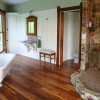Green Building Techniques
Kara O’ Brien Renovations has tackled green building from the start with our massive effort to recycle house parts, salvaged from other houses locally, parts that otherwise were headed to the landfill. We recycled entire housefuls of trim, mantels, fireplace tiles, antique bath and kitchen sinks, and old heart of pine flooring. In our first small house, we rescued a pallet of “scrap” marble from a marble supplier and installed it in the master bathroom. Recycling of architectural antiques was fulfilling and a win-win situation. We kept the house parts out of the landfills, paid a salvager to drive around parts of the City of Atlanta where builders were tearing down and throwing away old houses. The builders were saved from the labor of the demo and the high costs of dumpster fees. And ultimately, we got patina-rich lumber to restore and reinstall in old houses, new additions, or new constructio.
Green building is good for the environment and can be accomplished via many different avenues. In fact, it’s hard to pin down all the ways that green building is possible and we learn new techniques all the time, as the trend has caught on in the building industry. As we’ve grown as a company, we’ve continued to reuse & recycle house parts and have expanded the scope of what we recycle as well as add other sustainable energy saving techniques to our structures. We feel great knowing that our projects are better for the environment, healthier for occupants and save money over the long term. (embed a photo of the soy foam here
Some of the way that we build green:
Recycle house parts: We try to reclaim and recycle every usable part of demolished houses, restore, and reinstall them. We custom-craft cabinets from reclaimed beams and floor joists creating one of a kind kitchens. We repurpose trim, flooring, mantels, fireplace tile, baseboards, light fixtures, built-ins, stained glass windows, medicine cabinets, doors, flagstones, and hardware. As an example, we recently milled all of the woodwork for a 4400 sq. ft. house from reclaimed baseboards. We also recently crafted a double vanity and mirror frame from recycled mahogany pallets coming from Africa. We save and clean antique bricks & granite to be used for patios, exterior stairs, & walls.
Insulation: We have always insulated the walls & ceilings of our projects, but in recent times, we’ve begun sealing the house envelope with caulk and foam to reduce energy loss through plumbing and electrical holes. We’ve also been using low Volatile Organic Compound soy foam insulation. The foam is made from renewable American grown soy beans. The product is sprayed into all of the home’s cavities: floors, walls, and underneath the roof sheathing. The foam expands 100 times to fill every void and cavity creating a barrier and a thermal seal and dramatically reduces heating and cooling costs. We estimate that this is one of the best ways to reduce the carbon footprint of the structure.
Energy Saving Appliances: We recommend and choose Energy Star rated appliances for install whenever possible. We also promote the use of tankless hot water heaters for the vast amount of energy saving. Unlike standard water heaters, they only work on-demand, then turn off immediately afterwards. The choice of high efficiency HVAC systems also help conserve energy—the higher the SEER, the greater the savings.
Use of Sustainable Resources: When new materials are called upon for use, we search for projects or woods that are sustainable and inexpensive to produce. Ipe, bamboo, cork, & cumaru wood are examples of these materials harvested from managed growth forests. Solid wood flooring also reduces emission of VOCs into the home.
Passive Energy: There are several methods/ways to add passive energy to a building and we’ve used many of these. Solar tubes are a great way to add light to a space and take advantage of the sun’s energy without adding heat, UV rays or use electricity. We’ve also used the method of passive cooling by installing cupola windows that open & release rising heat via the chimney effect. Deep porches that wrap around a house or extend across the front of a house offer solar heat relief. The choice of Low-E windows also blocks solar heat absorption.
Low VOC (volatile organic compounds) paint: There are several options available now on the market for paints with zero volatile organic compounds or very low VOCs. We also advocate the use of shellac as a finish on wood trim or mantels, an organic finish with low VOCs.
Planting Trees: We try to plant lots of trees on our projects. Trees help absorb carbon monoxide and produce oxygen.
Xeriscaping: We have been planting shrubs and perennials that are native to our hot, dry Georgia climate and avoid sod when possible. We mulch our landscaping project with thick layers to retain the moisture in the soil and the roots.



